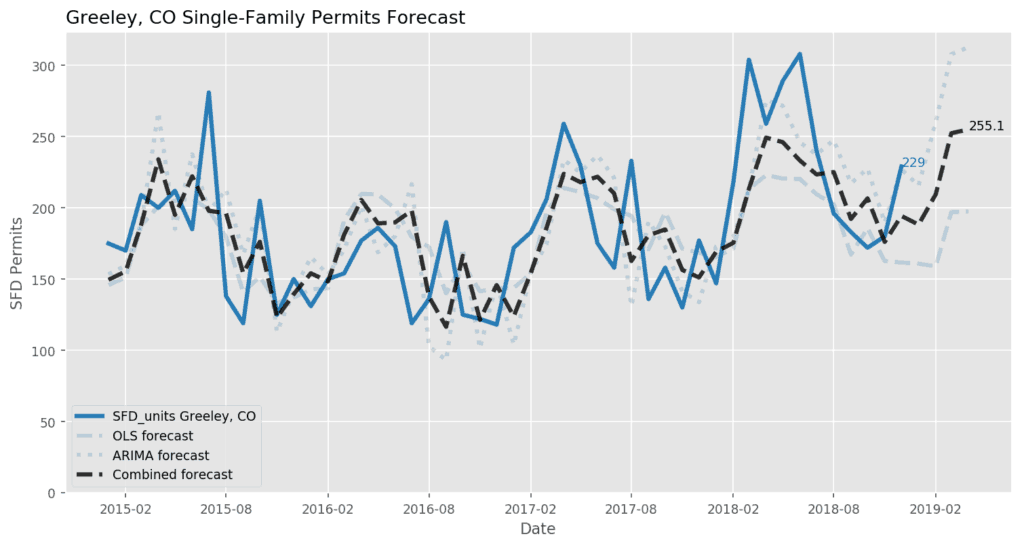Denver single-family permits are slowing, as multi-family permits spring back to life. Overall, Denver's housing market shouldn't yet be considered "slow," but "balanced."

Housing Permit Volume Down Overall
Denver single-family permits totaled 854 in November and 702 in December, versus the forecast for 929 and 996, respectively. The December single-family total is down 26% from December 2017. Multi-family permits have sprung back to life; after just 283 multi-family permit approvals in October, the data show 1,290 in November and 1,442 in December. This brings the 6-month average to a rate of 768 permits per month, compared to the forecast for 954. The total of 21,446 Denver housing permits for the year is 5% lower than 2017.
Median Home Price Increased by 3.2%, Down from 10% Rate of Appreciation
It's increasingly looking like the marginal homebuyer has capitulated after years of home price gains exceeding income growth. January sales volume was little changed year-over-year, but Redfin reports that the median Denver home sold for $392k, up just 3.2% from $380k one year ago. Denver home prices were increasing at over 10% per year as recently as early 2018.
No Affordability Gains Yet: Income has Increased, but so have Interest Rates
While it's promising that per-capita income in Denver increased by 5.2% in 2017, the latest year for which data is available, higher interest rates mean affordability has not improved. To wit, the monthly payment on a median-priced home after putting 20% down increased from $1,460 in January 2018 to $1,580 in Jan. 2019, an increase of 8.2%. 30-year fixed-rate mortage rates started 2018 at 4.0%, peaked at 4.9% in November and settled at 4.5% in January 2019.
Expect Few Interest Rate Hikes This Year
Home shoppers should applaud the Federal Reserve's recent change of attitude. Fed Chair Powell has signaled that the Fed will be "patient" in 2019 and will likely halt the process of balance sheet normalization sooner than previously anticipated.(1) Markets now expect as few as zero hikes of the federal funds rate in 2019, which would leave mortgage rates little changed from their current levels unless banks see significant changes to the economic outlook. Periods of broad economic growth should naturally be accompanied by increases in prevailing interest rates -- it's not clear whether mortgage rates' retreat in late 2018 and early 2019 should be attributed more to the Fed's change of tone or to volatile financial markets, perceptions of weakening economic growth in China and Europe, and softening domestic indicators like housing. The former could simply be the Fed responding to lukewarm inflation, whereas it would be more damaging to the outlook for housing in 2019 if the Fed perceives the change of policy as a response to serious economic weakness.
Denver Housing Market is Still Healthy
The good news is that even with softening conditions in the market, Denver housing shouldn't yet be considered "slow," but "balanced." While the sentiment of market participants has weakened somewhat, with both the NAHB's Housing Market Index survey of builders and the University of Michigan's Index of Consumer Sentiment falling in recent months, both measures remain solidly in positive territory. Similarly, the Denver unemployment rate has edged upwards, reaching 3.7% in December, but keep in mind that unemployment remains historically low. The Denver labor market continues to grow, with over 30k jobs added year-over-year. Moreover, mortgage delinquencies and foreclosures continue to signal that homeowner finances largely remain healthy, with both measures at or near multi-year lows.
With 1.8 Months Housing Supply, Denver Remains a Sellers' Market
The current supply of homes for sale in Denver is increasing but still resembles a sellers' market, as for-sale inventory would be exhausted in just 1.8 months at the current sales pace. A positive for homebuilders is that construction volume has been relatively low throughout this expansion, and it's clear that there has not been serious overbuilding like the last housing cycle. Nationally, the Census Bureau estimates the supply of newly-built homes for sale represents a six-month supply (2) which is a balanced level of inventory, although builders have increased their use of concessions, which include things like free upgraded flooring. (3)
More Entry-Level Homes Needed
The supply of new construction homes has consistently been higher than that of existing homes in recent years, and as builders have focused their efforts on larger homes for move-up buyers they may be grappling with a mismatch between the luxury product they've been building and the smaller homes desired by the first-time buyers who represent about 30% of home purchases. (4) The most successful homebuilders in 2019 will be those that successfully minimize cost pressures and cater to the entry-level market. (5)
No Need to Panic: Denver's Market Remains Strong
In short, Denver housing market conditions have begun softening, but it's important to remember that we're coming from a situation with robust demand that entirely outpaced supply and price gains that have surpassed income gains by a large margin. Through this lens, an increase in housing supply and slower price appreciation is a good thing. As I wrote in the last forecast, the Federal Reserve has started to "take the punch bowl away" by normalizing interest rates and reducing the balance sheet. These plans were met with stock market volatility and the Fed has since backed off from what they'd expected to do in 2019. Mortgage rates are key here as very low rates may be "priced-in" to current home values; if rates continue to climb then I would expect home values to fall somewhat to keep monthly payments attainable for the typical buyer. It's possible that the central bank will hit the sweet spot and extend the housing and economic cycle for the foreseeable future. In any case, I don't see evidence of a pricing or volume collapse in the near term.
January - April 2019 Permit Forecasts
Our forecast models predict single-family permit totals of 934 in January, 978 in February, 1,066 in March and 1,113 in April. The forecast is for 1,036 multi-family permit approvals per month for the six-month period ending in April.
Sources
(1) https://www.wsj.com/articles/jerome-powell-to-address-house-financial-services-committee-11551263400
(2) https://www.census.gov/construction/nrs/pdf/newressales.pdf
(3) https://www.latimes.com/business/la-fi-home-builders-slowdown-20190111-story.html
(4) https://www.prnewswire.com/news-releases/existing-home-sales-drop-1-2-percent-in-january-300799714.html
(5) https://www.wsj.com/articles/startup-backed-by-softbank-pours-money-into-a-bid-to-reshape-construction-11550581200
Market Indicators and Permit Forecasts
(Click to expand sections and see charts)
Not familiar with some of the terms below? Jump down to our economic data definitions.
Not familiar with some of the terms above? Jump down to our economic data definitions.
Economic Data Definitions
| SFD_units | This is the number of single-family housing permits approved in the metropolitan statistical area (MSA) each month, reported by the Census Bureau. |
| 2to4_units | This is the number of housing permits for units in buildings with two to four total units approved in the MSA each month, reported by the Census Bureau. |
| MF_units | This is the number of housing permits for units in buildings with five or more total units approved in the MSA each month, reported by the Census Bureau. |
| total_employment | This is total employment in the MSA, reported each month by the Bureau of Labor Statistics. |
| total_employment_yoy | This is the change in total employment in the MSA from one year ago. |
| unemployment_rate | This is the U-3 unemployment rate for each MSA reported by the Bureau of Labor Statistics. |
| construction_employment | This is total construction sector employment in the MSA, reported each month by the Bureau of Labor Statistics. This varies by availability in each location, some MSAs report residential building construction employment while some report only construction employment as a whole. |
| case_shiller | This is the S&P CoreLogic Case-Shiller Home Price Index for the MSA. This is a repeat-sales index, tracking price changes for individual homes that have sold multiple times. Jan. 2000 = 100. |
| FHFA_HPI | This is the Federal Housing Finance Agency’s House Price Index for the MSA. This is a repeat-sales index like Case-Shiller, but with coverage for more MSAs. |
| NAHB_HMI | This is the NAHB/Wells Fargo Housing Market Index (HMI) for the Census Region. The HMI is a survey of NAHB members measuring sentiment about the residential construction industry. The HMI is a diffusion index with values between 0-100; sentiment is negative at values below 50, neutral at 50, and positive over 50. |
| UM_CSENT | This is the University of Michigan’s Index of Consumer Sentiment. Survey data is used to estimate consumer optimism or pessimism. This is a national statistic. Mar. 1997 = 100. |
| construction_price_index | This is the Construction Price Index as reported by the Census Bureau, which gives an account of the costs to builders when building new homes. This is a national statistic. 2005 = 100. |
| RVR | This is the rental vacancy rate for the MSA as reported by the Census Bureau’s Housing Vacancies and Homeownership survey. These data are released quarterly and we use linear interpolation to estimate monthly figures. |
| hcai | This is the Housing Credit Availability Index published by the Urban Institute. A lower HCAI indicates that lenders are unwilling to tolerate defaults and are imposing tighter lending standards, while a higher HCAI indicates that lenders are willing to tolerate defaults and are taking more risks. |














